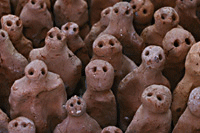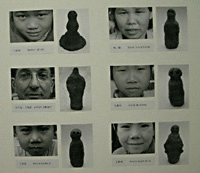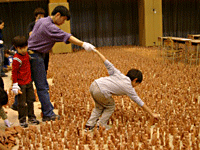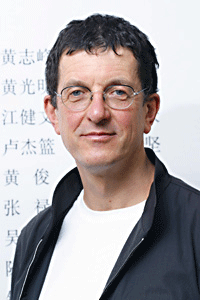A new world order in a school gym
2004年
'Asian Field' visits Tokyo
By KATE THOMSON
Special to The Japan Times
British sculptor Antony Gormley (born in London in 1950) is one of the foremost sculptors of his generation. A winner of the Turner Prize in 1994, Gormley is a conceptual artist working in a physical medium: He revitalized the sculptural vocabulary of the human form to articulate the universal abstract qualities of human experience.
 Antony Gormley's "Asian Field" figurines
Antony Gormley's "Asian Field" figurines
The basic concept of his global "Field" project, which began in 1989, is to go to a particular region and then ask people of all ages local to the clay, to form it into a surrogate world population. The project has now traveled to the four corners of the world including Brazil, Britain, Germany and Mexico. The Asian version of the project involved 350 people from Xiangshan village, northeast of the city of Guangzhou in south China, making 190,000 hand-size figures under Gormley's guidance from 125 tons of local red clay during an intensive five-day period in January 2003.
The result is a vast sculptural installation, which is currently on view until Nov. 28 in the gymnasium of a disused school in the heart of Roppongi, Tokyo. It stands as a unique image of self and community, invested with the time, love and personality of each individual maker, whose photographs are also on display.
The human body is the basis of all our sense of scale and form and has been central to making and understanding sculpture since its prehistoric beginning. In British art, religious, sexual and political icons have dominated public spaces since the Middle Ages. By the 1950s, the human figure had gone out of fashion in favor of abstract sculpture, but the subjective sense of our own proportions means that the human figure is still central to all sculpture for both artist and viewer.
 Pictures of the chinese makers
Pictures of the chinese makers
Gormley came to prominence in the 1980s for a series of sculptures based on his own body. These included the 1982 "Land, Sea and Air" project, which consisted of figures emerging from the sea on to a beach. He used his own form to make body casts clad in lead in simple, expressive poses. Rather than being purely representational though, Gormley's sculpture works reflexively; it links the act of perception with existence itself. Since the 1990s he has been awarded large-scale public art commissions in places around the world such as Osaka, Dublin, New York, Gateshead and London.
Rather than being privileged by being displayed in museums, his public works have become, in his own words "the plinth by which you feel your own living and the world that supports it more powerfully," as with the "Angel of the North" (1995-98), his 22-meter-high sculpture with 54-meter outstretched wings which stands on top of a hill in Gateshead, in northeast England.
"A sculpture's only real place is in the imagination of the viewer. Strange that something so physical can only find a real place within the mind," said Gormley during a talk last Friday at Roppongi's Academy Hills.
 Volunteers in the installation in Tokyo
Volunteers in the installation in Tokyo
The idea for "Field," which represents a radical departure from his previous way of working, came out of a sense of frustration with his own process. "Personally it was a crisis at the end of the 1980s," he said in an interview. "I had been working for more than 10 years in my own space and from my own body and in many ways I felt very isolated in this privileged position. I had been making work that was about the human condition but was itself very conditioned in the way it was made. I wanted to work differently, collaboratively, using human life as the engine, the very center of making the work. So I had to start all over again. I didn't want to use any of the supports of being a work of art."
He started working on the "Field" project 15 years ago in a rural community in Mexico, aiming in part to create a new audience, and also to create "a new way of making which goes back to what art was before it was called art." He was not sure how it would turn out. He experimented with clay, a sensitive material that provided a release from the the more inflexible way of working that body casting had locked him into.
The project was the first time Gormley had worked on such a scale. Gormley's "rules" were simple: The sculptures had to be hand-sized; they had to stand up; and they had to have two eyes. At first Gormley intended to do the eyes himself. "I was rushing round doing all these eye operations," he said. But he soon realized that this God-like process was untenable. He had to delegate more responsibility, expanding art from a form of self-expression into a kind of collective consciousness. "Field" capitalizes on the common human desire to make a personal mark on the world.
 Antony Gormley
Antony Gormley
Gormley also says the formation of a response is as creative a task as the initial production. In Xiangshan village, it was the children who responded best and who were teaching the parents as to how to go about making the figures. Another aim of "Field" was to "infect" a building so that it turns into "something imagined, a transformative space." In China the work was installed in an underground car park in the rapidly expanding city of Guangzhou; the National Museum of Modern Chinese History on Tianamen Square, Beijing; an old steel factory in Shanghai; and a department store in Chongqing.
The figures were then shipped to Tokyo for an exhibition co-sponsored by the Mori Art Museum, Nanjo & Associates and the British Council. In Tokyo, volunteers worked to install the piece. A young female volunteer said of the experience of working on the installation: "In the middle of this work, I wondered whether we could fill the space in time. But we did it. I am satisfied, because it is obvious what I did! I think passing figures hand to hand is one of the important meanings of this project. I felt a strong sense of the efforts of many people."
Kubo Shigeta, a 3rd-year sculpture student who had worked on the installation said: "Gormley's total concept is utsukushi ["beautiful"]. It wasn't the same as making my own work. But participating in the installation created a different, more personal impact when looking at the work."
Gormley has chosen to leave desks and chairs in the gymnasium, which was used as the school examination room, to amplify a point: The work invites its audience to go beyond the identity enforced by school. Behind all of this lies Gormley's desire for emancipation.
"Art should be an open, free space that liberates us from the pressure to conform to imposed ideologies or social norms," he says.
He is now happy for artists and communities interested in doing their own "Field" projects to go ahead without him. The sheer logisitics of organizing every phase of this project would prevent most people from ever attempting to take on "Field," but all visitors are invited to at least sign the message wall at the venue to record their own participation and response.
"Asian Field" is on show until Nov. 28 in the gymnasium of Johnan Tokyo Metropolitan Senior High School Roppongi 6-16-36, Minato-ku, Tokyo.
Open daily 11 a.m.- 8 p.m. (last day 5 p.m). For more information call (03) 3461-0890 or e-mail office@npoact.jp A map can be found at www1.britishcouncil.org/japan-arts-events-af-map.htm
Antony Gormley's work can be seen at www.antonygormley.com. Kate Thomson welcomes comments at www.ukishima.net
The Japan Times: Nov. 17, 2004
(C) All rights reserved